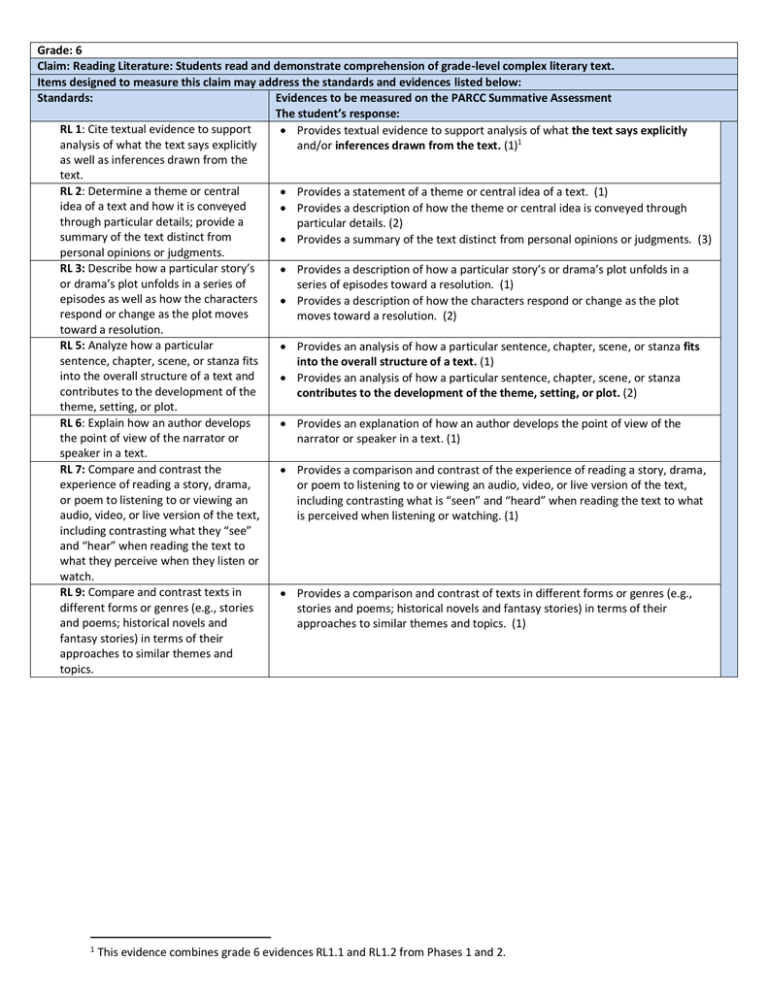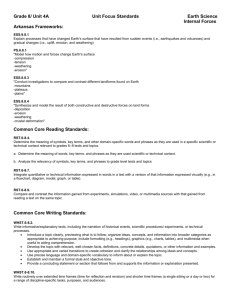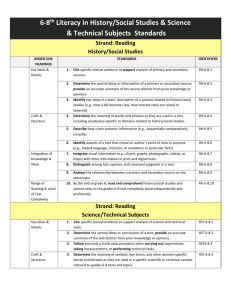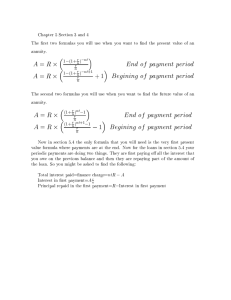PARCC Grade 6 Reading Evidence Tables
advertisement

Grade: 6 Claim: Reading Literature: Students read and demonstrate comprehension of grade-level complex literary text. Items designed to measure this claim may address the standards and evidences listed below: Standards: Evidences to be measured on the PARCC Summative Assessment The student’s response: RL 1: Cite textual evidence to support Provides textual evidence to support analysis of what the text says explicitly analysis of what the text says explicitly and/or inferences drawn from the text. (1)1 as well as inferences drawn from the text. RL 2: Determine a theme or central Provides a statement of a theme or central idea of a text. (1) idea of a text and how it is conveyed Provides a description of how the theme or central idea is conveyed through through particular details; provide a particular details. (2) summary of the text distinct from Provides a summary of the text distinct from personal opinions or judgments. (3) personal opinions or judgments. RL 3: Describe how a particular story’s Provides a description of how a particular story’s or drama’s plot unfolds in a or drama’s plot unfolds in a series of series of episodes toward a resolution. (1) episodes as well as how the characters Provides a description of how the characters respond or change as the plot respond or change as the plot moves moves toward a resolution. (2) toward a resolution. RL 5: Analyze how a particular Provides an analysis of how a particular sentence, chapter, scene, or stanza fits sentence, chapter, scene, or stanza fits into the overall structure of a text. (1) into the overall structure of a text and Provides an analysis of how a particular sentence, chapter, scene, or stanza contributes to the development of the contributes to the development of the theme, setting, or plot. (2) theme, setting, or plot. RL 6: Explain how an author develops Provides an explanation of how an author develops the point of view of the the point of view of the narrator or narrator or speaker in a text. (1) speaker in a text. RL 7: Compare and contrast the Provides a comparison and contrast of the experience of reading a story, drama, experience of reading a story, drama, or poem to listening to or viewing an audio, video, or live version of the text, or poem to listening to or viewing an including contrasting what is “seen” and “heard” when reading the text to what audio, video, or live version of the text, is perceived when listening or watching. (1) including contrasting what they “see” and “hear” when reading the text to what they perceive when they listen or watch. RL 9: Compare and contrast texts in Provides a comparison and contrast of texts in different forms or genres (e.g., different forms or genres (e.g., stories stories and poems; historical novels and fantasy stories) in terms of their and poems; historical novels and approaches to similar themes and topics. (1) fantasy stories) in terms of their approaches to similar themes and topics. 1 This evidence combines grade 6 evidences RL1.1 and RL1.2 from Phases 1 and 2. Grade: 6 Claim: Reading Information: Students read and demonstrate comprehension of grade-level complex informational texts. Items designed to measure this claim may address the standards and evidences listed below: Standards: Evidences to be measured on the PARCC Summative Assessment The student’s response: RI 1: Cite textual evidence to support analysis For RI 1, provides textual evidence to support analysis of what the of what the text says explicitly as well as text says explicitly and/or inferences drawn from the text. (1)2 inferences drawn from the text. For RST1 and RH1, provides textual evidence to support an analysis of RST 1: Cite specific textual evidence to support science and/or technical texts or historical primary and/or analysis of science and technical texts. secondary sources. (3) RH 1: Cite specific textual evidence to support analysis of primary and secondary sources. RI 2: Determine a central idea of a text and Provides a statement of the central idea(s) of a text. (1) how it is conveyed through particular details; Provides a statement of how the central idea is conveyed through provide a summary of the text distinct from particular details. (2) personal opinions or judgments. Provides an objective summary of the text distinct from personal RST 2: Determine the central ideas or opinions or judgments. (3) conclusions of a text; provide an accurate For RST 2, determines the central ideas or conclusions of a text. (4) summary of the text distinct from prior For RH 2, determines the central ideas of a primary or secondary knowledge or opinions. source. (5) RH 2: Determine the central ideas or information of a primary or secondary source; provide an accurate summary of the source distinct from prior knowledge or opinions. RI 3: Analyze in detail how a key individual, For RI3, analyze in detail how a key individual, event, or idea is event, or idea is introduced, illustrated, and introduced, illustrated, and/or elaborated in a text (e.g., through elaborated in a text (e.g., through examples or examples or anecdotes). (1)3 anecdotes). For RST 3, demonstrates ability to follow a multistep procedure when RST 3: Follow precisely a multistep procedure carrying out experiments, taking measurements, or performing when carrying out experiments, taking technical tasks. (4) measurements, or performing technical tasks. For RH 3, provides an identification of key steps in a text’s description of RH 3: Identify key steps in a text’s description a process related to history/social studies. (5) of a process related to history/social studies (e.g., how a bill becomes law, how interest rates are raised or lowered). RI 5: Analyze how a particular sentence, For RI 5, provides an analysis of how a particular sentence, paragraph, paragraph, chapter, or section fits into the chapter or section fits into the overall structure of a text. (1) overall structure of a text and contributes to For RI 5, provides an analysis of how a particular sentence, paragraph, the development of the ideas. chapter or section contributes to the development of the ideas. (2) RST 5: Analyze the structure an author uses to For RST 5, provides an analysis of the structure an author uses to organize a text, including how the major organize a text, including how major sections contribute to the whole sections contribute to the whole and to an and to an understanding of the topic. (3) understanding of the topic. For RH 5, provides a description of how a text presents information RH 5: Describe how a text presents (e.g. sequentially, comparatively, causally). (4) information (e.g., sequentially, comparatively, causally). RI 6: Determine an author’s point of view or For RI6, provides a statement of an author’s point of view in a text. purpose in a text and explain how it is (1) conveyed in the text. For RI6, provides a statement of an author’s purpose in a text. (2) RST 6: Analyze the author’s purpose in For RI6, provides an explanation of how the author’s point of view or providing an explanation, describing a purpose is conveyed in the text. (3) procedure, or discussing an experiment in a For RST 6, provides an analysis of the author’s purpose in providing an text. explanation, describing a procedure, or discussing an experiment in a RH 6: Identify aspects of a text that reveal an text. (4) author’s point of view or purpose (e.g., loaded 2 3 This evidence combines grade 6 evidences RI1.1 and RI1.2 from Phases 1 and 2. This evidence combines grade 6 evidences RI3.1, RI3.2 and RI3.3 from Phases 1 and 2. language, inclusion or avoidance of particular facts). RI 7: Integrate information presented in different media or formats (e.g., visually, quantitatively) as well as in words to develop a coherent understanding of a topic or issue. RST 7: Integrate quantitative or technical information expressed in words in a text with a version of that information expressed visually (e.g., in a flowchart, diagram, model, graph, or table). RH 7: Integrate visual information (e.g., in charts, graphs, photographs, videos, or maps) with other information in print and digital texts. RI 8: Trace and evaluate the argument and specific claims in a text, distinguishing claims that are supported by reasons and evidence from claims that are not. RST 8: Distinguish among facts, reasoned judgment based on research findings, and speculation in a text. RH 8: Distinguish among fact, opinion, and reasoned judgment in a text. RI9: Compare and contrast one author’s presentation of events with that of another (e.g., a memoir written by and a biography on the same person). RST 9: Compare and contrast the information gained from experiments, simulations, video, or multimedia sources with that gained from reading a text on the same topic. RH9: Analyze the relationship between a primary and secondary source on the same topic. For RH 6, provides an identification of aspects of a text that reveal an author’s point of view (e.g. loaded language, inclusion or avoidance of particular facts). (5) For RH 6, provides an identification of aspects of a text that reveal an author’s purpose (e.g. loaded language, inclusion or avoidance of particular facts). (6) For RI7, demonstrates a coherent understanding of a topic or issue that integrates information presented in different media or formats (e.g. visually, quantitatively) as well as in words. (1) For RST 7, provides an integration of quantitative or technical information expressed in words in a text with a version of that information expressed visually (e.g., in a flowchart, diagram, model, graph, or table). (2) For RH 7, provides an integration of visual information (e.g., in charts, graphs, photographs, videos, or maps) with other information in print and digital texts. (3) For RI8, provides a tracing of the argument and/or specific claims in a text. (1) For RI8, provides an evaluation of the argument and/or specific claims in a text. (2) For RI8, provides a statement distinguishing which claims of a text are supported by reasons and evidence and which claims are not supported. (3) For RST 8, provides distinctions among facts, reasoned judgment based on research findings, and/or speculation in a text. (4) For RH 8, provides distinctions made among fact, opinion, and/or reasoned judgment in a text. (5) For RI9, provides a comparison and contrast of one author’s presentation of events with that of another (e.g., a memoir written by and a biography on the same person). (1) For RST 9, provides a comparison and contrast of the information gained from experiments, simulations, video or multimedia sources with that gained from reading a text on the same topic. (2) For RH 9, provides an analysis of the relationship between a primary and secondary source on the same topic. (3) Grade: 6 Claim: Vocabulary Interpretation and Use: Students use context to determine the meaning of words and phrases. Items designed to measure this claim may address the standards and evidences listed below: Standards: Evidences to be measured on the PARCC Summative Assessment (The student’s response): RL 4: Determine the meaning of Demonstrates the ability to determine the meaning of words and phrases as they words and phrases as they are used in are used in a text (e.g., figurative, connotative) and/ or provides an analysis of a text, including figurative and the impact of specific word choice on meaning and/or tone. (1) connotative meanings; analyze the impact of a specific word choice on meaning and tone. RI 4: Determine the meaning of words and phrases as they are used in a text, including figurative, connotative, and technical meanings. RH 4: Determine the meaning of words and phrases as they are used in a text, including vocabulary specific to domains related to history/social studies. RST 4: Determine the meaning of symbols, key terms, and other domain-specific words and phrases as they are used in a specific scientific or technical context relevant to grades 6–8 texts and topics. L 4: Determine or clarify the meaning of unknown and multiple-meaning words and phrases based on grade 6 reading and content, choosing flexibly from a range of strategies. a. Use context (e.g., the overall meaning of a sentence or paragraph; a word’s position or function in a sentence) as a clue to the meaning of a word or phrase. b. Use common, grade-appropriate Greek or Latin affixes and roots as clues to the meaning of a word (e.g., audience, auditory, audible). c. Consult reference materials (e.g., dictionaries, glossaries, thesauruses), both print and digital, to find the pronunciation of a word or determine or clarify its precise meaning or its part of speech. d. Verify the preliminary determination of the meaning of a word or phrase (e.g., by checking the inferred meaning in context or in a dictionary). Demonstrates the ability to determine the meaning of words and phrases as they are used in a text (e.g., figurative, connotative, technical). (1) For RST 4, demonstrates the ability to determine the symbols and key terms that are used in a specific scientific or technical context relevant to grades 6–8 texts and topics. (2) FOR DIAGNOSTIC ONLY: Demonstrates the ability to determine the meaning of words and phrases as they are used in a text, including vocabulary specific to domains related to history/social studies. (3) FOR DIAGNOSTIC ONLY: Demonstrates the ability to determine the meaning of domain-specific words and phrases as they are used in a specific scientific or technical context relevant to grades 6-8 texts and topics. (4) Demonstrates the ability to use context (e.g., the overall meaning of a sentence or paragraph; a word’s position or function in a sentence) as a clue to the meaning of a word or phrase. (1) FOR DIAGNOSTIC ONLY: Demonstrates the ability to use common, gradeappropriate Greek or Latin affixes and roots as clues to the meaning of a word (e.g., audience, auditory, audible). (2) L 5: Demonstrate understanding of figurative language, word relationships, and nuances in word meanings. a. Interpret figures of speech (e.g.,personification) in context. b. Use the relationship between particular words (e.g., cause/effect, part/whole, item/category) to better understand each of the words. c. Distinguish among the connotations (associations) of words with similar denotations (definitions) (e.g., stingy, scrimping, economical, unwasteful, thrifty). L 6: Acquire and use accurately gradeappropriate general academic and domain-specific words and phrases; gather vocabulary knowledge when considering a word or phrase important to comprehension or expression. Demonstrates ability to determine the connotations (associations) of words with similar denotations (definitions) (e.g., stingy, scrimping, economical, unwasteful, thrifty). (1) Demonstrates ability to interpret figures of speech in context. (2) Demonstrates the ability to determine the relationship between particular words. (3) FOR DIAGNOSTIC ONLY: Demonstrates the ability to use the relationship between particular words (e.g., cause/effect, part/whole, item/category) to better understand each of the words. (4) Provides a statement demonstrating accurate meaning and use of gradeappropriate general academic words and phrases. (1)




